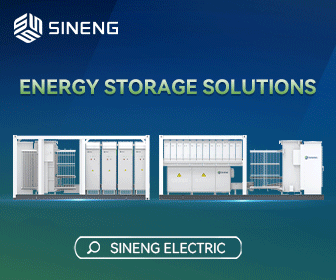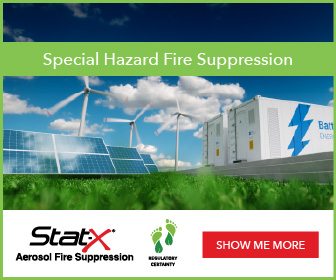Meeting California's New Home Solar Mandates with Battery-less Off-Grid Solutions
The solar industry in California is facing several challenges: (1) New California building codes require all newly built residential homes to incorporate rooftop PV solar beginning January 1, 2020. (2) Illustrated by the Duck Curve from California Independent System Operator (CA-ISO) in Figure 1, California's utility operators cannot accept much more on-grid solar power as it can create serious grid stability problems. A Duck Curve shows the grid capacity limitation for on-grid solar. (3) Battery storage can mitigate the Duck Curve problem, but batteries dramatically increase solar system costs and impact safety. (4) Utility companies may pay little for the solar power sent to the grid and may charge a monthly grid connection fee. (5) Uncertainties of on-grid solar economics may discourage homeowners to lock into a long-term on-grid solar purchasing or leasing program.
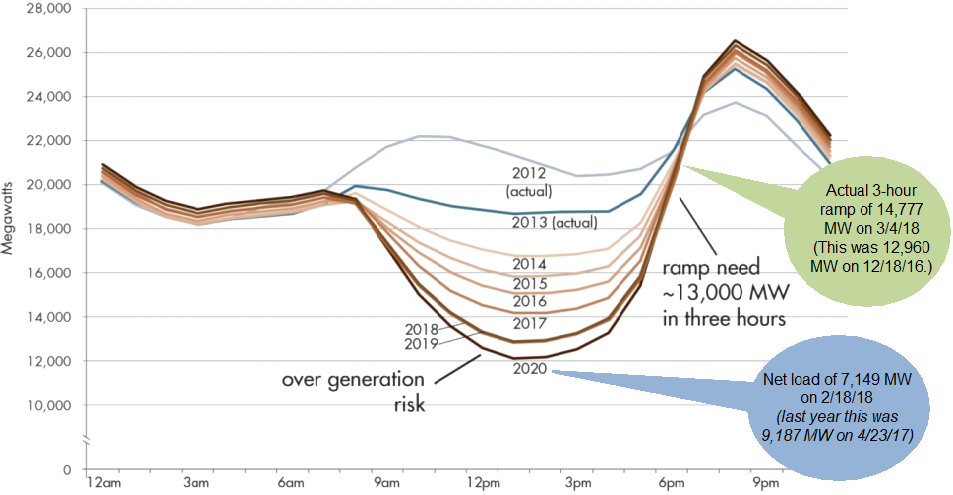
Figure 1
Battery-less off-grid solar
The optimal solution for new home builders to comply with the PV solar mandate is to go "off-grid", with no batteries. When most people hear the term "off-grid solar system", they may think of a remote cabin deep in the woods. However, a home with off-grid solar can still be connected to the electric grid. An off-grid solar PV system simply means that the electric power generated by the solar system never flows back to the grid. And the generated solar power is either consumed or stored, not in batteries, but in hot water or in the "coolth" of cooler air.
Off-grid PV water heating
Since running an electric water heater can consume a large portion of the electric bill, taking that load off the grid is a no brainer. As shown in Figure 2, an off-grid PV water heating system is actually quite simple. It includes multiple solar panels and an off-grid solar inverter designed for PV water heating. The inverter is connected to deliver solar energy to the lower heating element of the water heater. The temperature setpoint for the lower element can be purposely set much higher than the upper element; this way, the upper element that consumes grid power does not turn on unless a lot of hot water is used within a short period of time. Compared with thermal solar, PV water heating has many advantages: It is simple, clean, safe, cost-effective, and has no maintenance requirements - and packaged PV water heating systems are available on the market. What better way to save energy than in the form of hot water?
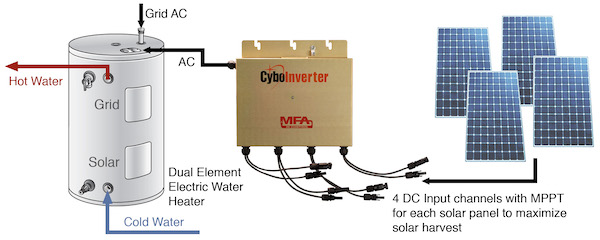
Figure 2
Off-grid solar for zone cooling and heating
Inverter-Air-Conditioners (IAC) or "mini-splits" are becoming more popular, because they are about 30% more efficient than a conventional air conditioning unit. Mini-splits can be started with small amounts of surge power, so they are well suited for being powered by battery-less off-grid solar systems, as shown in Figure 3. A digital timer can be programmed to run the system during the day when there is sufficient solar power. For homes with central A/C, it can still be economical to install one or more mini-splits in places such as the kitchen or living room to provide zone cooling or heating; the IAC can run during the day to cool or heat the zones, and save the energy in the form of air. After sunset, during the peak hours when the grid needs to ramp up power, the homeowner arrives home in a comfortable temperature - no need to turn on the central A/C. It's a great way to save electricity while help leveling the Duck Curve.
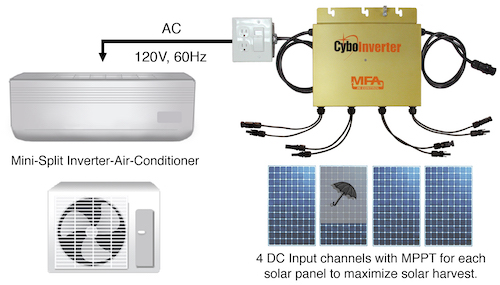
Figure 3
AC assisted off-grid solar system for heavy loads
Figure 4 shows an AC assisted off-grid solar system that can run 240V heavy loads, including central HVAC, IAC, swimming pool pumps, EV chargers, water pumps, clothes dryers, etc. With assisted AC input power, the system can run AC loads 24/7 with solar power, grid power, or combined power. It allows users to take major loads off the grid, and avoid the cost and potential curtailment of an on-grid solar system. By using a 30A dual-circuit or triple circuit timer, connected between the inverter output and the loads, you can schedule and run heavy AC loads individually.
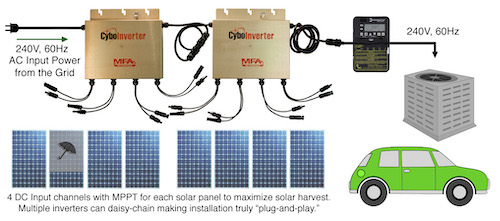
Figure 4
All-electric homes
Many home builders are choosing to offer all-electric homes, with no natural gas service. The builders' motivation is to reduce cost by eliminating the cost of running natural gas pipelines and exhaust systems. The utilities and municipalities are making the effort to make their communities greener by reducing emissions. For example, Sacramento Municipal Utility District (SMUD) now offers incentives up to $13,750 to convert an existing gas home to all electric.
The trend is clear: the goal of net zero energy homes is now shifting to net zero emission homes. Since it can be costly to power water heaters and other heavy loads with electricity, it is even more compelling for home builders and owners to take these loads off the grid with off-grid PV solar systems.
Go solar for new homes
Today, only 10 to 15 percent of new California homes include solar PV systems. As of January 2020, 100 percent of new California residential construction will require solar PV; this will drive the market for an additional 96,000 to 102,000 residential solar systems in California per year. California homes are already expensive, so home builders are seeking solutions to comply with the solar mandate at the lowest cost possible.
The lowest cost solar system will not include batteries. Battery backup systems have advantages of lowering demand charges and can arbitrage power costs (storing power when rates are low, and consuming battery power when rates are high). However, the disadvantages of batteries are cost and safety. Battery fires, though rare, are hazardous because they involve both electricity and potentially hazardous chemicals that can produce noxious fumes when burning.
Faced with Duck Curve issues and other dilemmas, the goal for designing a solar system is no longer per watt price. In fact, for most new home builders and homeowners, the goal is how to meet solar mandates with minimum investment, quickest ROI, and freedom of choice. Going off-grid without batteries, taking major loads off the grid, and signing no long-term contracts, will allow you to achieve these goals.
Dr. George S. Cheng is the CTO of CyboEnergy, which focuses on the development, manufacturing, marketing, and servicing of the product lines in the energy and clean energy field.
CyboEnergy | www.cyboenergy.com
Ray Martin is Vice President of IDL Global, a corporate advisory firm that specializes in providing services to companies with an emphasis on technology and investment banking services for strategic acquisitions, divestitures, corporate finance, joint ventures as well as technology and IP management.
IDL Global | www.linkedin.com/company/idl-global
Author: Dr. George S. Cheng and Ray Martin
Volume: 2019 September/October










